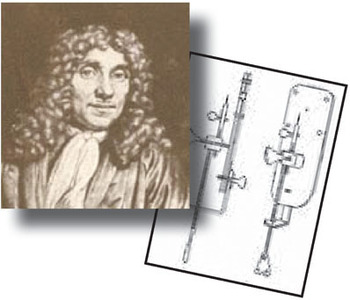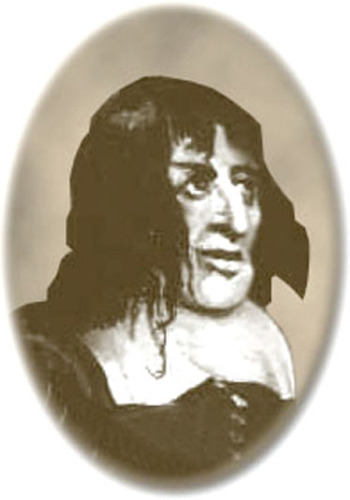
Robert Hooke (1635–1703)
Robert Hooke was a brilliant British experimental and theoretical scientist who lived and worked in London during the seventeenth century. As a child, Hooke suffered from a devastating case of smallpox that left him physically and emotionally scarred for the rest of his life. He was born the son of a minister on July 18, 1635, at Freshwater, on the Isle of Wight. Hooke's father, John Hooke, took an active role in Robert's early education until he entered the Westminster School at the age of thirteen following his father's suicide. After graduating Westminster in 1648, Hooke first conducted an apprenticeship with artist Sir Peter Lely and then entered Oxford University where he met and studied under some of the greatest scientists in England. Hooke eventually became a paid assistant for Robert Boyle and helped develop a working air pump. He remained in Boyle's laboratory until 1662 when he was made curator of experiments for the Royal Society of London, a job that entailed demonstration of scientific equipment and experimental procedures during weekly meetings of the entire society.

In 1663, Hooke was officially elected as a fellow of the Royal Society, and two years later he received an appointment as professor of geometry at Gresham College. The latter position was accompanied by a suite of rooms at the college where Hooke lived and worked for the rest of his life. During this period, Hooke's interest in microscopy and astronomy soared, and he published Micrographia, his best-known work on optical microscopy in 1665. The next year, Hooke published a volume on comets, Cometa, detailing his close observation of the comets occurring in 1664 and 1665. Later in 1666, he was appointed surveyor of London, shortly after the Great Fire, and designed a number of buildings, including the Royal College of Physicians, Bethlehem Hospital, and Montague House. After Henry Oldenburg's death in 1677, Hooke succeeded to the post of secretary of the Royal Society, which he maintained for the next sixteen years.
Micrographia encompassed the first important set of observations using an early microscope equipped with compound magnifying lenses and was illustrated by elaborate drawings (his finely detailed drawing of a flea is famous). Hooke observed a wide diversity of organisms, including insects, sponges, bryozoans, diatoms, and bird feathers. Perhaps less well known, Robert Hooke coined the term “cell,” in a biological context, as he described the microscopic structure of cork like a tiny, bare room or monk's cell in his landmark discovery of plant cells with cell walls. Hooke was able to confirm Leeuwenhoek's surprising observations of bacteria and protozoans, leading to the general acceptance of the Dutch scientist's results by the established scientific community. Hooke, much preferring his compound microscopes, did not conduct a substantial number of experiments with Leeuwenhoek-style microscopes and criticized these simple instruments as offensive to his eyes.
As the first to examine fossils with a microscope, Hooke noted the remarkable similarities between petrified wood and rotten oak wood, in addition to fossilized shells and living mollusk shells. These observations helped move science past Aristotle's misconceived notion that fossils formed and grew with the Earth and only imitated living things in nature, rather than the processes of speciation, fossilization, evolution, and extinction. Hooke's archaic language certainly described processes that explained the mineralization of living tissue into fossils and hinted at extinction and evolution, two and a half centuries before Charles Darwin. Micrographia also included a wave theory of light, which compared the spreading of light vibrations to undulating waves of water. Hooke followed the publication with a series of lectures on light to the Royal Society and was first to describe thin film phenomena and the associated periodicity using membranes and thin plates of mica. In 1672, he noted that light vibrates perpendicularly to the direction of its propagation.
Being the first to seriously consider the importance of the resolving power of optical equipment, Hooke advanced both microscopy and the development of telescopes. His contributions to optical instrument evolution include many innovations to the microscope, exemplified by the invention of the compound microscope and the creation of an ingenious illumination system. Hooke developed a micrometer and was the first to apply telescopic sights to surveying instruments. A refractometer to measure the refractive index of liquids, the addition of a spiral gear to adjust the setting of telescopes, the universal joint (of automobile fame), the iris diaphragm, and a lens-grinding machine are all attributable to this British scientist, architect, cartographer, and musician.
Looking toward the stars as the inventor of the reflecting telescope, Hooke's ventures into astronomy include the first inference to the rotation of Jupiter and the description of its Great Red Spot. He also observed the rotation of Mars, attempted to observe and describe parallax, and noted one of the earliest examples of a double star. In addition to its voluminous references to optical microscopy, Micrographia includes notes on Hooke's observations of lunar craters and speculates on their origin. He formulated the theory of planetary motion, as a problem in mechanics, which led Newton to his theories surrounding gravitational laws. Although his twenty-year work on gravity was innovative, it lacked some of the mathematical sophistication of Newton's, which quickly overshadowed Hooke's theories and speculation.
Hooke dabbled widely in the sciences and arts and is often referred to as the founder of meteorological sciences (he proposed setting zero degrees Centigrade as the freezing point of water) and a pioneer in early geology, especially with regard to fossils and crystals. He was an expert in earthquakes and developed theories of combustion and a law of elasticity that still bears his name. Hooke was a very active inventor and innovator of a wide spectrum of scientific instruments beyond his microscope work. These include the modern air pump, spring-driven watches, several types of barometers, a depth-sounding machine, an air gun, carriages, windmills, a telegraph, a diving bell, surveying equipment, and various levels and scales. Robert Hooke believed strongly that instruments were to be viewed as extensions of the human senses.
As England's version of Leonardo da Vinci, Hooke's reputation suffered greatly during his lifetime because of intellectual property disputes and his apparent conflicts with other prominent scientists (who often had much more influence in the Royal Society). As an example, Hooke clashed with Christiaan Huygens over the spring regulator, and he had numerous battles with Sir Isaac Newton, first over optics in 1672 and then again in 1686 over the inverse square law of gravitation. Tragically, Hooke died intestate in 1703 with 9,580 pounds to his name. His health had severely deteriorated during his last seven years of life, and he was plagued with an illustrious career that was greatly overshadowed by his mortal enemy, Isaac Newton. Historians investigating Newton's Principia, and Hooke's involvement in the early development of this famous volume, have since yielded some overdue credit and helped restore his reputation. Unfortunately, Hooke's only known portrait and many of his inventions and papers have not survived the centuries. Perhaps a good portion of this dilemma is attributable to Newton's total distain for Hooke, which was manifested in numerous and legendary attempts to obliterate Robert Hooke from any association with the Royal Society and his significant contributions to science. Even his grave site remains unknown.
The Hooke microscope. Although Hooke did not make his own microscopes, he was heavily involved with the overall design and optical characteristics. The microscopes were actually made by London instrument maker Christopher Cock, who enjoyed a great deal of success due to the popularity of this microscope design and Hooke's book. The Hooke microscope shared several common features with telescopes of the period: an eyecup to maintain the correct distance between the eye and eyepiece, separate draw tubes for focusing, and a ball and socket joint for inclining the body. The microscope body tube was constructed of wood and/or pasteboard and covered with fine leather. When the draw tubes were fully closed the microscope measured six inches long. Although the craftsmanship and design of this microscope was excellent, it suffered from a poorly executed focusing mechanism that would tend to wear very quickly and unevenly.


